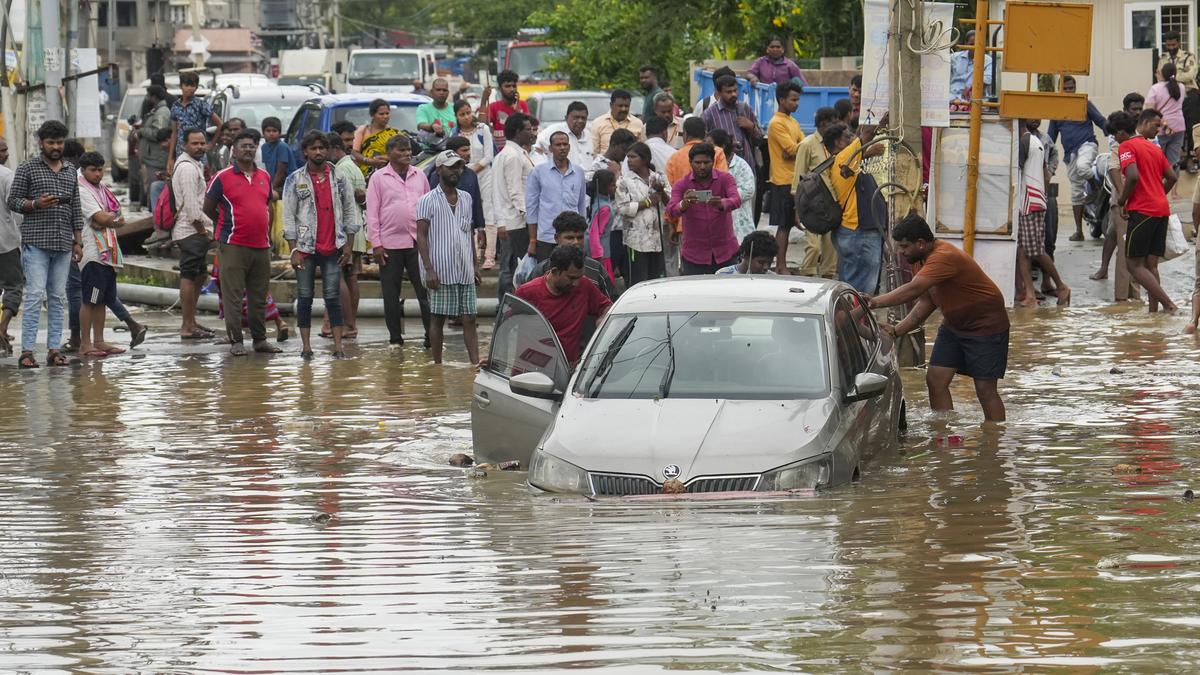People attempt to push out a car from a waterlogged road after heavy rains, at Sai layout in Bengaluru, on May 19, 2025.
| Photo Credit: PTI
For long-time residents of Bengaluru, it is beginning to feel like there is too much happening all at once. There are talks of extending Namma Metro to neighbouring cities. Work has started for a suburban rail network. The State government is busy pushing for a contentious network of tunnel roads to connect traffic-choked ends. And the civic body, the Bruhat Bengaluru Mahanagara Palike (BBMP), is being split into multiple corporations with the hope that they will manage the city better.
Ironically, while these projects are being planned keeping the city’s future in mind, there is little thought being given to existing problems, which arose out of Bengaluru’s “growth”. All it takes is for the sky to open up a few times for all that lies beneath the shine of ‘Brand Bengaluru’ to be exposed. For the motorists caught on dangerously waterlogged roads, the residents of layouts that are inundated after a few spells of rain, and the families of those who lost their lives in a a flooded underpass or a tree fall, the statements of ministers promising removal of encroachments only provide a sense of déjà vu.
Spotlight | Bengaluru under water yet again
The Chief Minister’s Office said in a recent statement that the pre-monsoon rains in 2025 were the highest recorded during the season and in the month of May in the last 125 years. The rainfall recorded in the pre-monsoon period (March 1 to May 31) was 286 mm against the normal 115 mm. The actual rainfall was 219 mm against the normal 74 mm for May. The India Meteorological Department, Bengaluru, said the city received a record 307.9 mm of rainfall between May 1 and May 26 (till 11.30 a.m.). Bengaluru received a staggering 105.5 mm of rainfall in the 24-hour period between 8.30 a.m. on May 18 and 8.30 a.m. on May 19 — the second highest since 2011. This caught the authorities, who were still preparing for the monsoon, off guard.
High-impact weather events have been occurring more frequently and with greater intensity globally. Many parts of Bengaluru were under water during the monsoon and post-monsoon seasons in 2015, 2017, 2020, and 2022. In 2023, Karnataka was hit by drought, which led to a water crisis in many parts of the State in 2024.
Why, then, have the civic authorities not learned any lessons? Bengaluru was once famed for its network of lakes. These served as flood management tools by harvesting rainwater and storing excess water. As the city grew, the government focused on providing piped water supply from the Cauvery river. It ignored lakes to the point where hundreds of them disappeared, making way for real estate, stadiums, and bus stands. Rivers that originate or flow through the city, such as the Vrushabhavathy, continue to be in a state of neglect.
During the 2024 summer water crisis, the Bangalore Water Supply and Sewerage Board came up with a knee-jerk response. It filled up a few lakes with treated water to push up groundwater levels. This year, 63 of the 183 lakes under the BBMP have already reached full capacity before the monsoon season, raising questions about how important flood-mitigation barriers have been compromised.
Citizen activists and experts have also repeatedly pointed to the reduced carrying capacity of drains due to the build-up of silt and flow of sewage. This has caused rainwater to overflow into the streets, leading to severe water-logging.
The Karnataka Lokayukta, which took up a suo motu case about flooding in Bengaluru after the recent episode, said that the main reasons for flooding were negligence of officials and lack of coordination between various agencies. Justice B.S. Patil also directed officials to speed up de-silting work of drains, ensure a gradient to facilitate flow of water in them, and remove all encroachments on drains.
Also Read | Bengaluru rains: Its a long struggle for people in flooded layouts
Bengaluru is in the throes of an administrative transformation as the Greater Bengaluru Authority (GBA) will replace the BBMP, which came into being in 2007, as the city’s primary governing body. The GBA aims to bring all the major agencies working in Bengaluru under one structure, which will be headed by the Chief Minister of Karnataka. Some civic activists fear this will result in centralisation of administration and power.
Will this lead to a more cohesive and comprehensive approach to managing the city, especially in the light of extreme weather events? Or will the residents continue to suffer the same problems as the focus remains on extravagant projects? It is too early to tell.
Published – June 02, 2025 12:15 am IST

